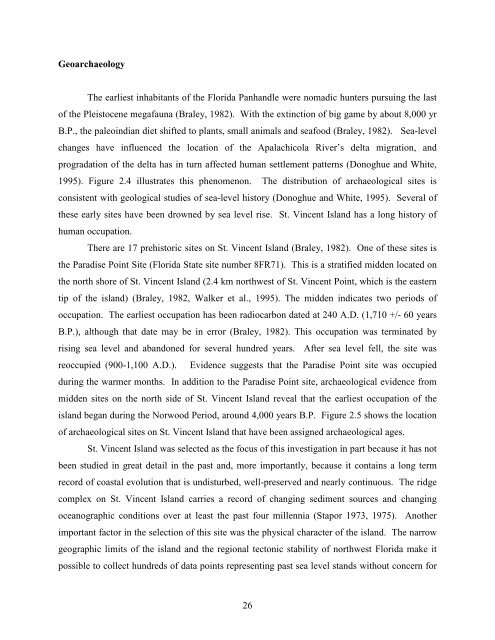the florida state university college of arts and sciences evolution of ...
the florida state university college of arts and sciences evolution of ...
the florida state university college of arts and sciences evolution of ...
You also want an ePaper? Increase the reach of your titles
YUMPU automatically turns print PDFs into web optimized ePapers that Google loves.
Geoarchaeology<br />
The earliest inhabitants <strong>of</strong> <strong>the</strong> Florida Panh<strong>and</strong>le were nomadic hunters pursuing <strong>the</strong> last<br />
<strong>of</strong> <strong>the</strong> Pleistocene megafauna (Braley, 1982). With <strong>the</strong> extinction <strong>of</strong> big game by about 8,000 yr<br />
B.P., <strong>the</strong> paleoindian diet shifted to plants, small animals <strong>and</strong> seafood (Braley, 1982). Sea-level<br />
changes have influenced <strong>the</strong> location <strong>of</strong> <strong>the</strong> Apalachicola River’s delta migration, <strong>and</strong><br />
progradation <strong>of</strong> <strong>the</strong> delta has in turn affected human settlement patterns (Donoghue <strong>and</strong> White,<br />
1995). Figure 2.4 illustrates this phenomenon. The distribution <strong>of</strong> archaeological sites is<br />
consistent with geological studies <strong>of</strong> sea-level history (Donoghue <strong>and</strong> White, 1995). Several <strong>of</strong><br />
<strong>the</strong>se early sites have been drowned by sea level rise. St. Vincent Isl<strong>and</strong> has a long history <strong>of</strong><br />
human occupation.<br />
There are 17 prehistoric sites on St. Vincent Isl<strong>and</strong> (Braley, 1982). One <strong>of</strong> <strong>the</strong>se sites is<br />
<strong>the</strong> Paradise Point Site (Florida State site number 8FR71). This is a stratified midden located on<br />
<strong>the</strong> north shore <strong>of</strong> St. Vincent Isl<strong>and</strong> (2.4 km northwest <strong>of</strong> St. Vincent Point, which is <strong>the</strong> eastern<br />
tip <strong>of</strong> <strong>the</strong> isl<strong>and</strong>) (Braley, 1982, Walker et al., 1995). The midden indicates two periods <strong>of</strong><br />
occupation. The earliest occupation has been radiocarbon dated at 240 A.D. (1,710 +/- 60 years<br />
B.P.), although that date may be in error (Braley, 1982). This occupation was terminated by<br />
rising sea level <strong>and</strong> ab<strong>and</strong>oned for several hundred years. After sea level fell, <strong>the</strong> site was<br />
reoccupied (900-1,100 A.D.). Evidence suggests that <strong>the</strong> Paradise Point site was occupied<br />
during <strong>the</strong> warmer months. In addition to <strong>the</strong> Paradise Point site, archaeological evidence from<br />
midden sites on <strong>the</strong> north side <strong>of</strong> St. Vincent Isl<strong>and</strong> reveal that <strong>the</strong> earliest occupation <strong>of</strong> <strong>the</strong><br />
isl<strong>and</strong> began during <strong>the</strong> Norwood Period, around 4,000 years B.P. Figure 2.5 shows <strong>the</strong> location<br />
<strong>of</strong> archaeological sites on St. Vincent Isl<strong>and</strong> that have been assigned archaeological ages.<br />
St. Vincent Isl<strong>and</strong> was selected as <strong>the</strong> focus <strong>of</strong> this investigation in part because it has not<br />
been studied in great detail in <strong>the</strong> past <strong>and</strong>, more importantly, because it contains a long term<br />
record <strong>of</strong> coastal <strong>evolution</strong> that is undisturbed, well-preserved <strong>and</strong> nearly continuous. The ridge<br />
complex on St. Vincent Isl<strong>and</strong> carries a record <strong>of</strong> changing sediment sources <strong>and</strong> changing<br />
oceanographic conditions over at least <strong>the</strong> past four millennia (Stapor 1973, 1975). Ano<strong>the</strong>r<br />
important factor in <strong>the</strong> selection <strong>of</strong> this site was <strong>the</strong> physical character <strong>of</strong> <strong>the</strong> isl<strong>and</strong>. The narrow<br />
geographic limits <strong>of</strong> <strong>the</strong> isl<strong>and</strong> <strong>and</strong> <strong>the</strong> regional tectonic stability <strong>of</strong> northwest Florida make it<br />
possible to collect hundreds <strong>of</strong> data points representing past sea level st<strong>and</strong>s without concern for<br />
26

















